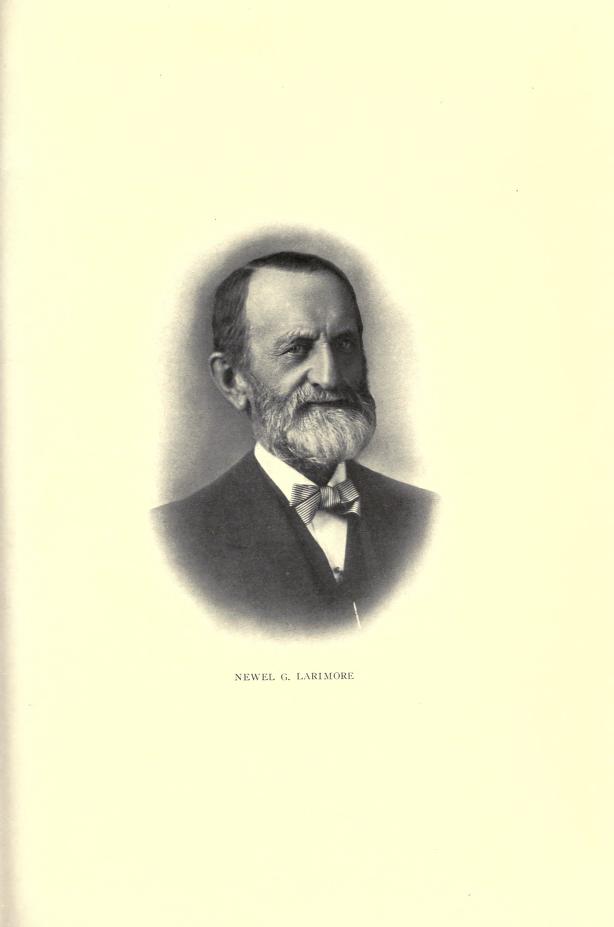Newell Green Larimore, born August 29, 1835, in Bourbon County, Kentucky, was the son of Wilson L. Larimore and Harriet Berry Larimore. Raised on a farm in St. Louis County, Missouri, he graduated from Wyman’s High School. He married Susan Ashbrook in 1855, with whom he had two sons, Walter L. and Clay. After Susan’s death in 1862, he married Mollie E. Jameson in 1867, and had two more children, Jameson and Cora. Larimore co-founded several companies, including the St. Louis Warehouse Company and the Central Elevator Company. He also played significant roles in civic organizations and farming enterprises in St. Louis and North Dakota.
Newell Green Larimore, of Larimore, was born August 29, 1835, in Bourbon County, Kentucky. His father was Wilson L. Larimore, and his mother, Harriet Berry Larimore. His father’s great-grandfather came to Kentucky from the eastern shore of Maryland. Early ancestors on his father’s side were Huguenots, in France. Ancestors of his mother came from England to America in the Mayflower.
The subject of the sketch was reared on a farm in St. Louis County, Missouri, and later attended and graduated from the Wymans High School, in St. Louis. When but twenty years of age he was married, September 2, 1855, to Miss Susan Ashbrook. Two sons, Walter L. and Clay, blessed this union. His first wife died July 25, 1862. Mr. Larimore was married again on April 4, 1867, to Miss Mollie E. Jameson, a niece of his first wife, making Walter and Clay cousins of their stepmother. One son, Jameson, and one daughter, Cora, were born to them.
At the close of the Civil War, Mr. Larimore and his brother organized the St. Louis Warehouse Company, which erected a building covering an entire block. On its completion, the use of the warehouse was donated for two months to the ladies, to hold the Southern Relief Fair, through which about $60,000 were realized and turned over to the proper authorities, for the relief of those made destitute by the war.
In 1870, the Central Elevator Company was organized in St. Louis by Mr. Larimore. Several large elevators were built, and the company continued handling grain until 1885. In 1873, the first telephone line in St. Louis was built, to connect the company’s office and three of its elevators, and was about one mile in length.
During the early seventies, the city of St. Louis was controlled by a ring of grafters. The citizens held a mass meeting, and demanded that the board of trade select seven men to be elected at large, for the upper house of the city council, for four years. The demand was acceded to, and Mr. Larimore was one of the members elected. During that four years, contracts for granite street paving were let, which required ten years to complete and grafting was barred for at least ten years. Mr. Larimore was a charter member of the St. Louis Club, the first and still the most exclusive in St. Louis. He was also a charter member of the Veiled Prophets, a rival of the New Orleans Mardi Gras. In 1879, he went to Paris to order the costumes for the order.
In 1880, Mr. Larimore, with others, organized the Elk Valley Farming Company, which began farming operations in Grand Forks County in 1881, and which has developed one of the largest and most successful farming enterprises in the country, comprising about 12,000 acres of cultivated land adjacent to the city of Larimore.
Mr. Larimore was president of the board of trustees of the University of North Dakota under Governor Shortridge. He has been one of the trustees of the Red River Valley University, and Wesley College, since its organization. For about eight years, he was president of the North Dakota Chautauqua Association. He has been for about five years a member of the National Irrigation Association, and is local vice-president of the American Sunday School Union. He has been a member of the Trans-Mississippi Commercial Congress since its organization, and vice-president for twelve years. The object of this organization is largely to induce Congress in making appropriations for internal improvements, to recognize the fact that the trans-Mississippi country is on the map, and part of the United States. Prior to the organization of the Trans-Mississippi Congress, the section of the country east of the Mississippi River had absorbed all of the appropriations for internal improvements. For years, little attention was given to the congress, but more recently requests of this body of business men have received respectful attention. The organization pushed through Congress the opening of Galveston Harbor, and the improvement of the mouth of the Mississippi River, affording an outlet for the grain of Kansas, Nebraska, and the Southwest; also for the cotton of the South, relieving the congestion of the railroads east of the Mississippi River, thus preventing a continued advance in rates.
Source
C.F. Cooper & Company, History of the Red River Valley, Past And Present: Including an Account of the Counties, Cities, Towns And Villages of the Valley From the Time of Their First Settlement And Formation, volumes 1-2; Grand Forks: Herald printing company, 1909.

